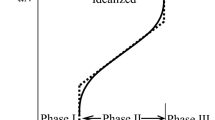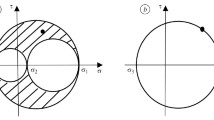Abstract
Fatigue damage assessment is carried out considering mean value effect by applying four criteria of failure. Three frequency domain methods, i.e., level crossing counting (LCC), range counting (RC) and a new proposed method, are applied. The core of frequency domain method is the construction of probability density function for the mean stress and stress range of the stress process. The applicability of these frequency domain methods are inspected by comparing with time domain method. Numerical simulations verify the applicability of LCC and the proposed method, while RC gives poor estimations.
Similar content being viewed by others
References
Thies P R, Johanning L, Harnois V et al. Mooring line fatigue damage evaluation for floating marine energy converters: Field measurements and prediction [J]. Renewable Energy, 2014, 63: 133–144.
Gujar R A, Bhaskar S V. Shaft design under fatigue loading by using modified Goodman method [J]. International Journal of Engineering Research and Applications, 2013, 3(4):1061–1066.
Li Z, Ringsberg J W, Storhaug G. Time-domain fatigue assessment of ship side-shell structures [J]. International Journal of Fatigue, 2013, 55: 276–290.
Ariduru S. Fatigue Life Calculation by Rainflow Cycle Counting Method [D]. Middle East Technical University, Ankara, Turkey, 2004.
Liu X C, Feng G Q, Ren H L. Study on the application of spectral fatigue analysis [J]. Journal of Marine Science and Application, 2006, 5(2):42–46.
Tempel J V D. Design of Support Structures for Offshore Wind Turbines [D]. Delft University of Technology, Delft, Netherlands, 2006.
Stoica P, Moses R L. Spectral Analysis of Signals [M]. Prentice Hall, USA, 2005.
Mrsnik M, Slavic J, Boltezar M. Frequency-domain methods for a vibration-fatigue-life estimation-Application to real data [J]. International Journal of Fatigue, 2013, 47: 8–17.
Budynas R, Nisbett K. Shigley’s Mechanical Engineering Design [M]. McGraw-Hill, USA, 2008.
Tovo R. Cycle distribution and fatigue damage under broad-band random loading [J]. International Journal of Fatigue, 2002, 24(11): 1137–1147.
Benasciutti D, Tovo R. Spectral methods for lifetime prediction under wide-band stationary random processes [J]. International Journal of Fatigue, 2005, 27(8): 867–877.
Dirlik T. Applications of Computers in Fatigue Analysis [D]. University of Warwick, UK, 1985.
Naser J M. Analysis of Vibration-induced Fatigue Cracking in Steel Bridges [D]. Chalmers University of Technology, Göteborg, Sweden, 2010.
Shinozuka M, Deodatis G. Simulation of stochastic processes by spectral representation[J]. Applied Mechanics Reviews, 1991, 44(4): 191–204.
Hu B, Schiehlen W. On the simulation of stochastic processes by spectral representation [J]. Probabilistic Engineering Mechanics, 1997, 12(2): 105–113.
Author information
Authors and Affiliations
Corresponding author
Additional information
Supported by the National Natural Science Foundation of China (No. 51379142 and No. 51309179), the International Science and Technology Cooperation Program of China (No. 2012DFA70490) and the Tianjin Municipal Natural Science Foundation (No. 13JCYBJC19100).
Ding Hongyan, born in 1963, male, Dr, Prof.
Rights and permissions
About this article
Cite this article
Ding, H., Zhu, Q. & Zhang, P. Fatigue damage assessment by considering mean value effect in frequency domain. Trans. Tianjin Univ. 21, 161–166 (2015). https://doi.org/10.1007/s12209-015-2502-0
Accepted:
Published:
Issue Date:
DOI: https://doi.org/10.1007/s12209-015-2502-0




